Type species: Antheraea mylitta (Drury, 1773).
A genus of about 40 species confined almost exclusively to the eastern Palaearctic and Oriental regions; however, four species are endemic to North America and two have been introduced from China and Japan into Europe.
HOSTPLANT FAMILIES: Mainly trees of the Fagaceae.
UK: Japanese Oak Silkmoth; Japanese Tensan Silkmoth, F: Saturnie du chêne du Japon, D: Japanischer Eichenseidenspinner, H: Tölgy-pávaszem; Tölgy-selyemlepke, PL: Jedwabnik debowy, FIN: Japanintammisilkkikehrääjä, N: Japansk eikepåfuglspinner.
Bombyx yamamai Guérin-Méneville, 1861, Revue Mag. Zool. (2)13: 187.
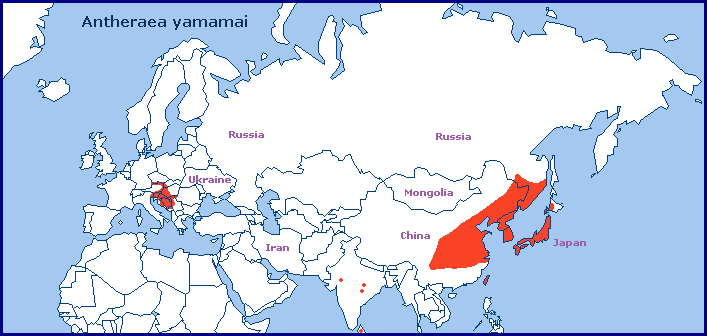
Type locality: Japan.
[Further details on this species, as well as photos of all stages, can be found on Lepiforum.]
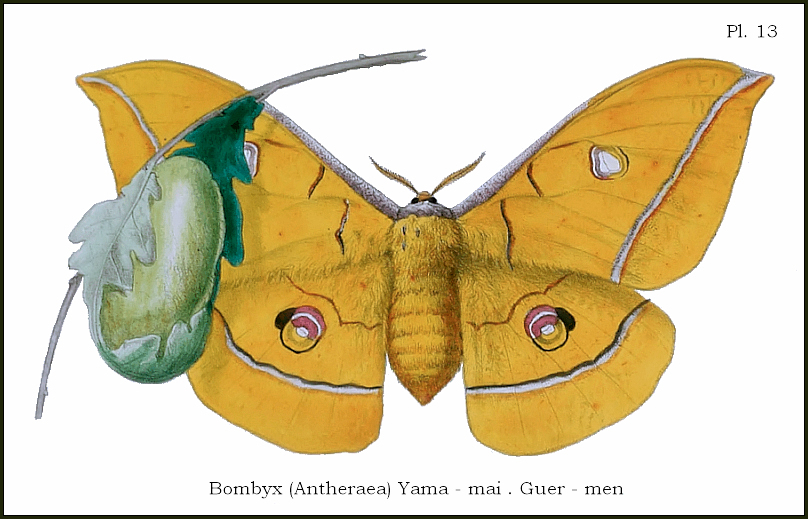
Holarctic; eastern Palaearctic region. Pleistocene refuge: ?Monocentric -- Japanese refuge. ?Introduced elsewhere.
Wingspan 110--152mm. The similarly marked and coloured sexes are unlike any other european saturniid except the introduced Antheraea pernyi, but can easily be distinguished from that species by an elongated solid black spot on the outer margin of the hindwing eyespot. In males, the forewings are distinctly falcate.
This species is very variable in colour, with individuals ranging from the typical sandy-yellow of the female illustrated below through brownish-grey, chocolate-brown, bronze, reddish-brown, khaki to chromium-yellow. The last colour form, which comes with red and pale pink markings, is rare in males.
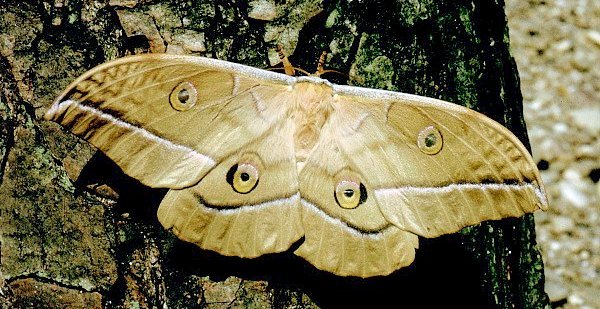
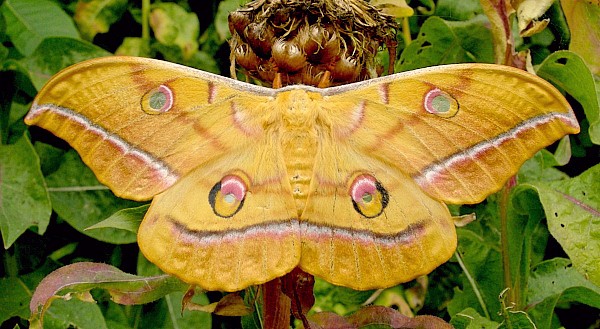
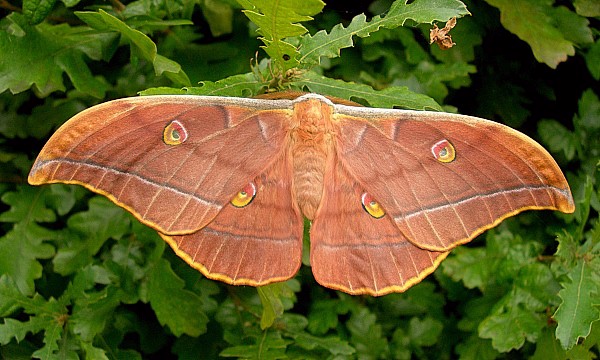
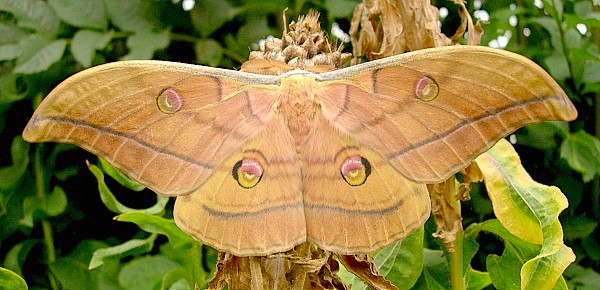
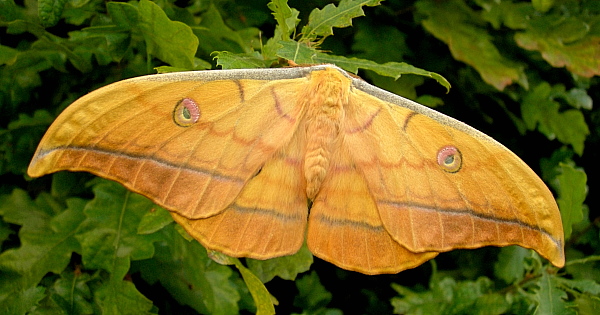
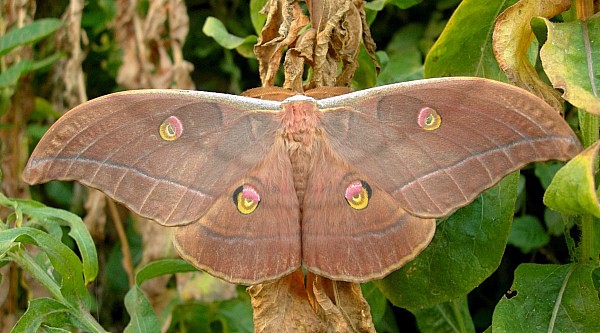
A nocturnal species which frequents deciduous forests and tree-rich lowlands dominated by oaks (Quercus spp.).
Most adults emerge in the late afternoon or evening, with many females calling that same night. Pairing usually takes place just before midnight and lasts for about three hours. After separation, the male flies off in search of another mate. The female then clambers around laying eggs in neat rows on the nearest twigs. The reason for this odd behaviour is that most females carry too many eggs at first and are 'bottom-heavy'. This stop-start process continues until about 30 eggs have been deposited. The rest of the eggs are laid on the wing over a larger area.
Both sexes of this species are readily attracted to light and can be found by day 'resting' on posts and walls below these, where they usually remain unmolested. In Austria, adults are often hunted among foliage (where adults normally rest) by the Golden Oriole (Oriolus oriolus), from which they may try to escape by immediately taking to the wing and flying vertically into the sky while dodging the birds' attempts at capture. However, the main escape tactic is to let go at the slightest disturbance and drop down among the foliage, or down to the forest floor. Here they will lie motionless among the leaf litter for some time, even upside down. The cryptically-coloured wings blend in well with spent yellow, brown and copper-coloured leaves.
Mainly from the second week of August into September as a single generation. However, in northern Italy (Friuli-Venezia Giulia) it has been seen as early as late June.
OVUM: Round to slightly oval, dorso-ventrally flattened, 2.6 x 2.5mm, china-white with brown gum. Laid in chains of up to eight on the twigs of the host and not hatching until April of the following year. The overwintering stage.
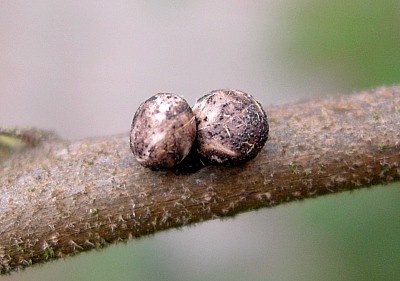
LARVA: Full-fed 80--90mm. Monomorphic.
The newly-hatched, 5mm long larvae consume part of their eggshells and then wander off some distance to find suitable resting sites among a cluster of oak leaves. At this stage they are basically greenish-yellow with five longitudinal black stripes. The dorsal and dorso-lateral tubercles are yellow with black setae; the ventro-lateral tubercles are black.
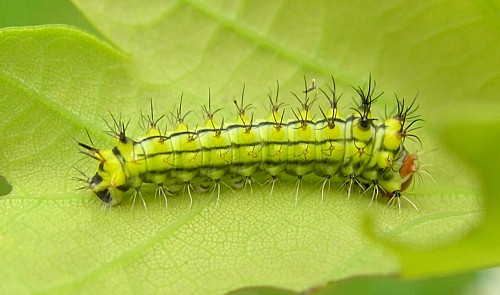
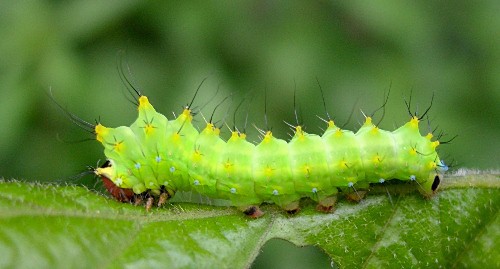
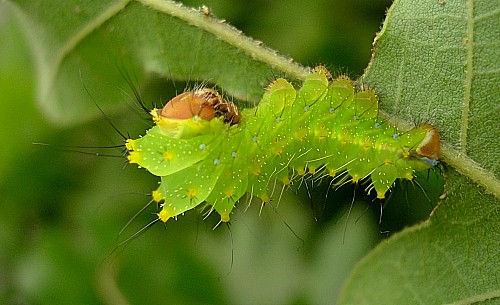
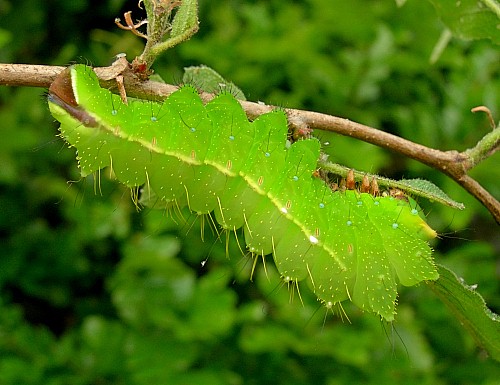
In the second instar the basic body colour becomes apple-green, the longitudinal black lines vanish, the lateral yellow tubercles become tipped with blue, the head and legs become brown, and a pale yellow band appears above the abdominal spiracles. This basic colour scheme persists into the final instar, but with the head becoming greenish, and metallic 'drops' appearing laterally in the fourth instar. In the fifth instar (illustrated below), the tubercles become insignificant and are replaced by tufts of yellow hair.
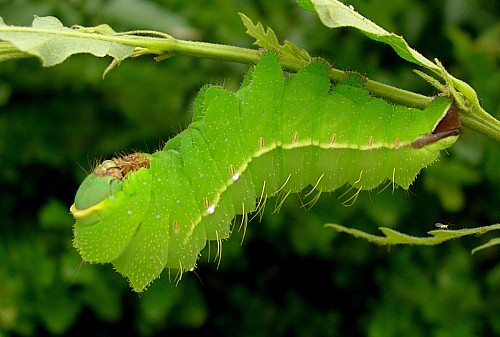
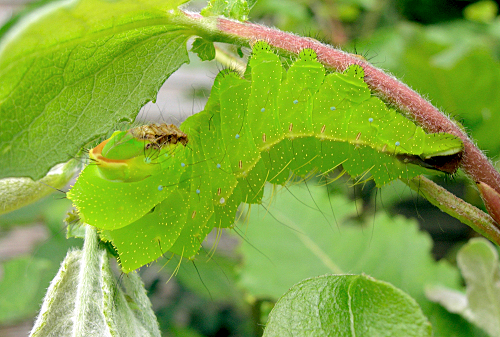
Newly emerged larvae take some days to settle down under a leaf. From the third instar onwards many larvae exhibit a kind of 'wanderlust', feeding at one spot for about four days before wandering off along the branches to a new location. This may be a survival strategy, for in it's latter stages great quantities of foliage are consumed -- the stout and compact larvae rely on cryptic coloration for concealment as they hang among a leaf cluster.
Hostplants. Many species of oak (Quercus); however, it can also be found on beech (Fagus sylvatica), sweet chestnut (Castanea sativa), hornbeams (Carpinus), wild roses (Rosa) and hawthorns (Crataegus). Other trees/shrubs can also serve as hosts on occasions, such as Salix caprea, but this is rare.
PUPA: 35--45mm.
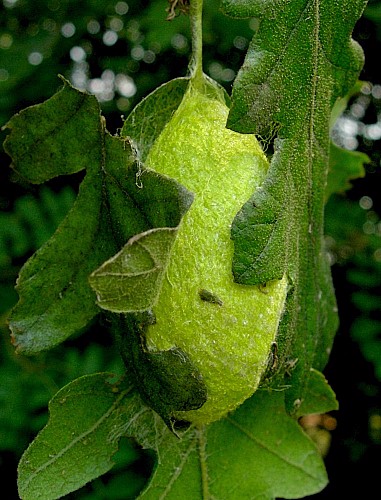
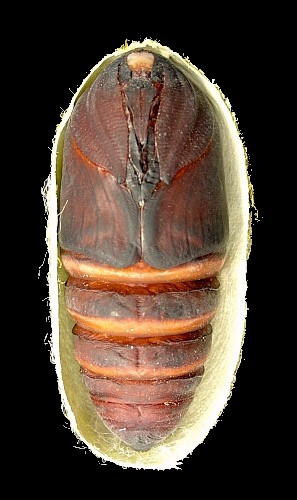
Cylindrical, but tapering towards both ends -- mahogany-brown. Formed in a tight, hard, oval, single, sealed, yellow to bright green cocoon with a loose, whitish outer wrap. The cocoon is soft at first but hardens up when impregnated with an hardening fluid. This dries out to leave a white, powdery residue. Spun up in a cluster of leaves but fixed to the nearest twig by a silk peduncle. The adult breaks out of this in late summer by softening and partially dissolving one end.
Ichneumonidae: Pimpla rufipes (Miller, 1759) [syn. Pimpla instigator (Fabricius, 1793)]; Trichogrammatidae: Trichogramma chilonis Ishii, 1941; Tachinidae: Exorista sorbillans (Wiedemann, 1830), Nemoraea pellucida (Meigen, 1824).
An introduced species whose natural home is the eastern Palaearctic (Japan). It is now widespread in central Europe in northeastern Italy around Chiusaforte (Casale, 1973; Parenzan & Porcelli, 2006; Bossi & Karabatsos, 2019; Glerean, Deutsch, Morandini, Morin & Huemer, 2022), southern and eastern Austria (Walzl, 1985), southern Czechia (Veronika Kučerová, iNaturalist 2014), western Hungary (Kovács, 1953; Macek et al., 2007), Slovenia (Michieli, 1963), Croatia (Kovacevic & Franjevic-Otrc, 1978), Bosnia (Hanjalic & Lelo, 2014) and Serbia (ivojinovic & Vasic, 1963). In recent years (since 2001) it has started to spread more widely, with individuals having been found in Montenegro (Nahirnic & Beshkov, 2015), Romania and eastern Bavaria (near Passau), Germany (Schmidt & Weigert, 2006; Paul Kastner, iNaturalist 2024) and Slovakia. On top of this, amateur breeders often release this species so that individuals can turn up amost anywhere.
The introduction of this species into Europe has been documented by Bostjan Dvorak of Slovenia. It was originally reared in 1866 by a Johann Mach, the village teacher in Veliki Slatnik (near Novo Mesto, Slovenia), with a view to establishing a silk industry producing tensan silk. In August 1868 a number of adults escaped into the wild and, although the rearing scheme failed, larvae were found in the area on hornbeam a few years later. From that time onwards adults were increasingly found during August/September on the walls of houses in the village, and in nearby woods and settlements. Ten years later the first adults were picked up in Ljubljana. [An interesting follow-on from this is that the son of Johann Mach, Ernst Mach, became an eminent professor of physics at the universities of Graz, Prague and Vienna, and gave his name to the term 'Mach number'.]
Extra-limital range. Besides it's native Japan, where it has been cultivated for more than 1000 years, this subspecies can also be found in Taiwan, Sri Lanka and India as an introduction. It is not known whether this species is native to the Russian Far East and mainland China; it may have been introduced from Japan centuries ago for 'wild' silk production.
Five, namely bergmani Bryk (1949), superba Inoue (1964), titan Mell (1958), ussuriensis Schachbazov (1953), and yambaru Kishida, 2020. These are distributed from the Russian Far East (Izerskiy, 1999a) south through Korea, China (to Zhejiang and Sichuan Province) and Taiwan; the last is from Okinawa Island, Japan (Kishida, 2020).
 Return to species list
Return to species list